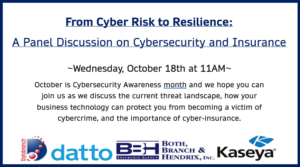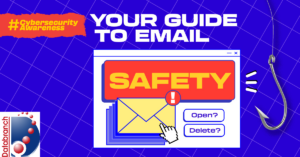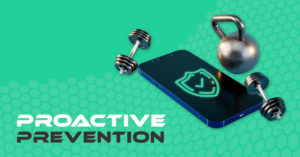
Databranch is partnering with Both Branch & Hendrix Inc. along with Datto to present a webinar on Wednesday, October 18th at 11AM, titled “From Cyber Risks to Resilience: A Panel Discussion on Cybersecurity and Insurance.“
In this session we will discuss:
- How A Cyberinsurance Policy Works
- What a Standard Cyber Policy Includes
- Rise in Business Email Compromises
- Good Password Hygiene
- End-User Security Training/Phishing Awareness
- Business Continuity – Recoverability in the Event of a Cyber Incident – BC/DR & Datto SaaS
- and more!
In our increasingly interconnected world, cyber threats continue to evolve at an alarming rate, posing significant risks to individuals and their organizations.
As we venture into the future, it is crucial to anticipate the potential threats and understand the importance of implementing robust cybersecurity measures.
Join us to learn from:
- Mike Hendrix – an Accredited Advisor in Insurance (AAI) that has been with Both, Branch & Hendrix since 1983.
- Mike Wilson – the President of Databranch, a MSP company serving local, national and international businesses since 1985.
- Taylor Thorson – a Channel Development Manager for Datto/Kaseya, the leader in Total Data Protection.
October is Cybersecurity Awareness month and we hope you can join us as we discuss the current threat landscape, how your business technology can protect you from becoming a victim of cybercrime, and the importance of cyber-insurance.
Register for our webinar here! Reach out to Databranch today at 716-373-4467 option 6, or [email protected] to learn how we can enhance your businesses cybersecurity posture.
Read More

Phishing scams remain one of the most prevalent and successful types of cyberattacks today, so being aware of the danger they pose to businesses like yours is extremely crucial. Your business could easily be the next victim if you don’t clearly understand how threat actors leverage phishing emails.
In this blog, you’ll learn the intent behind phishing emails, the various types of phishing attacks, and most importantly, how you can secure your email and business.
The Goal Behind Phishing Emails
Cybercriminals use phishing emails to lure unsuspecting victims into taking actions that will affect business operations, such as sending money, sharing passwords, downloading malware or revealing sensitive data. The primary intent behind a phishing attack is to steal your money, data or both.
Financial theft — The most common aim of a phishing attempt is to steal your money. Scammers use various tactics, such as business email compromise (BEC), to carry out fraudulent fund transfers or ransomware attacks to extort money.
Data theft — For cybercriminals, your data, such as usernames and passwords, identity information (e.g., social security numbers) and financial data (e.g., credit card numbers or bank account information), is as good as gold. They can use your login credentials to commit financial thefts or inject malware. Your sensitive data can also be sold on the dark web for profit.
Be vigilant and look out for these phishing attempts:
- If an email asks you to click on a link, be wary. Scammers send out phishing emails with links containing malicious software that can steal your data and personal information.
- If an email directs you to a website, be cautious. It could be a malicious website that can steal your personal information, such as your login credentials.
- If an email contains an attachment, be alert. Malicious extensions disguised to look like a document, invoice or voicemail can infect your computer and steal your personal information.
- If an email tries to rush you into taking an urgent action, such as transferring funds, be suspicious. Try to verify the authenticity of the request before taking any action.
Different Types of Phishing
It’s important to note that phishing attacks are constantly evolving and can target businesses of all sizes. While phishing emails are a common method used by cybercriminals, they also use texts, voice calls and social media messaging.
Here are the different kinds of phishing traps that you should watch out for:
Spear phishing — Scammers send highly personalized emails targeting individuals or businesses to convince them to share sensitive information such as login credentials or credit card information. Spear phishing emails are also used for spreading infected malware.
Whaling — A type of spear phishing, whale phishing or whaling is a scam targeting high-level executives where the perpetrators impersonate trusted sources or websites to steal information or money.
Smishing — An increasingly popular form of cyberattack, smishing uses text messages claiming to be from trusted sources to convince victims to share sensitive information or send money.
Vishing — Cybercriminals use vishing or voice phishing to call victims while impersonating somebody from the IRS, a bank or the victim’s office, to name a few. The primary intent of voice phishing is to convince the victim to share sensitive personal information.
Business email compromise (BEC) — A BEC is a spear phishing attack that uses a seemingly legitimate email address to trick the recipient, who is often a senior-level executive. The most common aim of a BEC scam is to convince an employee to send money to the cybercriminal while making them believe they are performing a legitimate, authorized business transaction.
Angler phishing — Also known as social media phishing, this type of scam primarily targets social media users. Cybercriminals with fake customer service accounts trick disgruntled customers into revealing their sensitive information, including bank details. Scammers often target financial institutions and e-commerce businesses.
Brand impersonation — Also known as brand spoofing, brand impersonation is a type of phishing scam carried out using emails, texts, voice calls and social media messages. Cybercriminals impersonate a popular business to trick its customers into revealing sensitive information. While brand impersonation is targeted mainly at the customers, the incident can tarnish the brand image.
Bolster Your Email Security
Emails are crucial for the success of your business. However, implementing email best practices and safety standards on your own can be challenging. That’s why you should consider partnering with a Managed IT service provider like Databranch.
We have the resources and tools to protect your business from cyberattacks, helping you to focus on critical tasks without any worry. We also have ongoing and interactive employee cybersecurity training that will help your company keep up with cybercriminals and their ever-changing tactics.
Meanwhile, to learn how to secure your inbox, download our eBook — Your Guide to Email Safety — that will help you improve your email security and avoid potential traps.
Read More

Your business, in all likelihood, already faces numerous challenges in today’s tech-driven world. However, the aftermath of an unexpected disaster can push your organization to its breaking point. This unintentionally creates opportunities for cybercriminals to launch devastating attacks, amplifying the chaos caused by such events.
Disaster preparedness should be a top priority for your business — not only for physical resilience but also for fortifying your digital defenses. By understanding how disasters fuel cyberattacks, you can proactively safeguard your business against these deceptive threats.
Understanding How Disasters Amplify Cyberthreats
Let’s look at four major ways disasters amplify cyberthreats and what strategies you can utilize to bolster your cybersecurity posture in the face of adversity.
1. Leveraging Diverted Attention and Resources
When a disaster strikes, the immediate focus shifts toward safety and recovery. Unfortunately, this diverts attention and resources away from maintaining and protecting your IT systems and networks.
With a reduced emphasis on cybersecurity measures, essential updates and monitoring may be overlooked, leaving your networks vulnerable to intrusion. Cybercriminals seize this opportunity to infiltrate your systems, compromise sensitive data and disrupt your operations.
To tackle this situation, establish a dedicated team responsible for monitoring and maintaining cybersecurity, even during times of crisis. For our managed clients, Databranch takes this one step further by implementing automated security systems to scan for vulnerabilities and apply necessary patches continuously.
By ensuring cybersecurity remains a priority, even in challenging times, you can minimize the risk of cyberattacks
2. Exploiting Fear, Urgency, Chaos and Uncertainty
Disasters create an environment of fear, urgency, chaos and uncertainty — prime conditions for cybercriminals to thrive in. They launch targeted attacks, such as deceptive emails or fraudulent websites, capitalizing on the sense of urgency and the need for quick solutions. By manipulating individuals into disclosing sensitive information, cybercriminals gain unauthorized access to critical systems. They could also sell this sensitive data on the dark web.
To combat this, educate your employees about the tactics used in phishing attacks and social engineering scams. Train them to recognize warning signs, such as suspicious emails or requests for sensitive information. Encourage a culture of skepticism and verification, where employees double-check the authenticity of requests before sharing confidential data.
By fostering a vigilant and informed workforce, you can fortify your defense against cybercriminals seeking to exploit fear and uncertainty. Visit us here to download our cybersecurity culture checklist.
3. Damaging Critical Infrastructure
Disasters can cause severe damage to your critical infrastructure, compromising components integral to your cybersecurity measures. Destruction of servers, routers or firewalls can weaken your defense mechanisms, allowing cybercriminals to exploit security gaps.
To address this challenge, ensure your critical infrastructure has backup and disaster recovery in place. Regularly back up your data, store it securely off-site or in the cloud, and test the restoration process to ensure it functions smoothly. Implement robust disaster recovery and business continuity plans, including provisions for cybersecurity.
By maintaining resilient infrastructure and regularly testing your backup and recovery processes, you can mitigate the impact of infrastructure damage on your cybersecurity.
4. Impersonation and Deception
In the wake of a disaster, cybercriminals often exploit the trust associated with relief organizations and government agencies. By impersonating these trusted sources, they deceive victims through phishing emails, messages or calls, tricking them into divulging sensitive information or engaging in fraudulent transactions.
To protect yourself from such scams:
- Encourage your employees to verify the authenticity of any communication received during a disaster.
- Advise them to independently contact the organization or agency through known, trusted channels to confirm the legitimacy of any requests.
- Establish robust security awareness training programs that educate employees about common impersonation tactics and teach them how to report them effectively.
By promoting a culture of caution and verification, you can defend against impersonation and deception tactics used by cybercriminals. Our phishing infographic is a great educational resource that can be shared with your workforce to prepare them for real life threats.
Act Now to Safeguard Your Business
Now that we know how cybercriminals can target your business during a disaster, prioritizing disaster preparedness and implementing the above-highlighted measures are important to navigate today’s ever-evolving technology landscape.
If you need expert guidance, Databranch is here to help fortify your disaster preparedness and cybersecurity efforts. Together, let’s ensure a resilient and secure future for your business. Contact us today at 716-373-4467 x6 or [email protected] to proactively safeguard what you’ve worked so hard to build.
Read More

A disaster preparedness plan helps businesses withstand any calamity. However, many businesses are unaware that a cybersecurity strategy is also crucial for building a robust disaster preparedness plan.
By incorporating cybersecurity into your emergency preparedness plan, you can better protect your business during critical incidents and minimize the impact of cyberthreats. This will help you enhance your business’s resilience, ensuring you’re better equipped to function in the face of unexpected challenges.
Best Practices for Effective Disaster Preparedness Planning in IT Security
Here are some practical tips for improving your organization’s disaster preparedness planning:
1. Protect Your IT infrastructure and Data
Your data is a gold mine for cybercriminals, and they’ll do anything to get their hands on it. That’s why it’s important to strengthen your IT infrastructure to withstand any disaster. Failing to implement adequate measures to protect your data could also attract fines and lawsuits.
Pro tip
- Firewalls, intrusion detection systems and encryptions can strengthen your IT security.
- Implementing a process to fix and update software patches regularly will help you avoid security vulnerabilities.
2. Back up Critical Data
Data loss can occur for many reasons, including cyberattacks and natural disasters. If your organization has not correctly backed up its data, recovery can be costly, time-consuming and seemingly impossible. Visit Databranch here to utilize out Recovery Time Calculator and see just how costly a disaster can be for your company.
If you want your business to survive, your disaster preparedness plan must ensure that your data remains clean, available and restorable.
Pro tip
- Regularly back up critical data.
- Back up your data off-site or in the cloud.
- Test backups regularly to verify their integrity.
Here at Databranch, our disaster recovery solution not only ensures that your data is restored to its former state, but restored quickly, with little to no downtime or interruption to your business.
3. Improve Employee Awareness
Your employees are your weakest link only if they don’t have proper training. By conducting regular security awareness training, you can improve their knowledge. It also increases your employees’ ability and willingness to follow security protocols during an emergency.
Pro tip
- Train your employees to identify phishing attempts, report suspicious activities and follow security protocols.
- Promote a culture of preparedness.
- Routinely test employee preparedness through simulated scenarios or drills.
Databranch offers ongoing and interactive training to help you stay secure and keep up with cybercriminals and their ever-changing tactics. Our Breach Prevention Platform and Security Awareness Training will give your employees the resources they need to spot real world phishing attempts.
4. Review Insurance Policies
Insurance plays a critical role in promoting disaster resilience and can help speed up your recovery after an incident. It’s a good idea to have property insurance, business interruption insurance, and cybersecurity insurance to cover all bases.
Pro tip
- Routinely review insurance policies to ensure you have proper coverage for potential risks and disasters.
- Maintain records of your assets, inventory and financial transactions to facilitate insurance claims and recovery efforts.
- Take the help of an insurance expert to understand current coverage and determine if additional coverage is required.
5. Evaluate Vendor and Supplier Preparedness
Disasters come unannounced and any weak link in your supply chain will only increase your vulnerability. Knowing if your vendor has a disaster preparedness plan is crucial for protecting your customers and overall business operations.
Pro tip
- Ensure your vendors’ or suppliers’ disaster preparedness practices align with your plans.
- Ask your vendor to share their disaster communication plan with you.
- Recommend that your suppliers test their disaster plan at least once a year.
- Guide them to an experienced service provider such as Databranch if they express needing assistance
6. Review and Revise Your Preparedness Strategies
It’s essential to test your preparedness plan for weaknesses and shortcomings regularly. By testing, you can fix the gaps and strengthen your strategy. A thoroughly tested plan will protect your data and help you avoid revenue loss during an outage, cyberattack or natural disaster.
Pro tip
- Extensively document changes in the organization, including people, processes and resources.
- Conduct mock tests to gauge the preparedness of your plan and employees.
- Take the help of an IT service provider to enhance your plan. They can also carry out timely audits to test the effectiveness of your program.
Databranch Can Help You Outlast Disasters
It can be challenging to build a comprehensive disaster preparedness plan that is robust and includes a thorough cybersecurity strategy on your own. By partnering with Databranch, your business can become resilient and outlast any disaster.
Contact us today at 716-373-4467 x6 or [email protected] to see how we can help your business build a solid disaster preparedness plan. You can also download our disaster preparedness eBook by filling out the form below.
Read More

Databranch has been notified about a new Microsoft support scam that is generated after users click on a false Amazon ad.
Clicking on this sponsored Google ad will redirect users to a Microsoft technical support scam. This scam will claim to be Windows Defender, stating that your device has been infected with malware.
Why is this Noteworthy:
Google search engine is widely used by consumers worldwide. Users often click the top results, which are ‘Sponsored’ results. Currently, those who are searching for Amazon are at risk of being a victim by scammers.
A similar scam was seen last year through YouTube ads where it displays a website’s legitimate URL but leads to the scam website.
This presents a major security concern as scammers who gain access to a computer can not only install malware, but can also steal personal and financial information.
Recommendations:
- Avoid clicking on Amazon sponsored Google ads
- Visit website by their Fully Qualified Domain Name (FQDN)
Please feel free to reach out to [email protected] with any questions.
If you are not a managed client and would like to discuss how Databranch can help to proactively manage, monitor, and patch your IT environment, please reach out to Databranch at 716-373-4467 option 6 or [email protected].
Read More

In today’s rapidly evolving threat landscape, employee cybersecurity training is crucial. It acts as the frontline defense against cyberattacks, empowering your workforce to identify and mitigate potential threats. However, to ensure the effectiveness of your training program, you should take all the steps necessary to avoid common mistakes that can undermine your efforts.
Let’s uncover these pitfalls and learn how to steer clear of them. By addressing challenges head-on, you can maximize the impact of your employee cybersecurity training.
Stay proactive and informed to create a culture of security awareness that empowers employees as vigilant defenders against cybercrime. Together, we’ll equip your workforce with the skills they need to keep your organization secure.
Mistakes to avoid
Don’t let these preventable mistakes hinder your cybersecurity initiatives:
Approaching security training as a one-off activity
Don’t treat cybersecurity training as a mere checkbox exercise. Instead, foster a culture of continuous learning by providing regular opportunities for your employees to stay updated on the latest threats and security best practices. Make security awareness an ongoing journey rather than a one-time event.
Delivering dull, outdated and unrelatable training
Engagement is vital to proper training. Avoid dry and obsolete content that fails to capture your employees’ attention. Instead, strive to provide training that is timely, engaging and relatable. Leverage interactive platforms and user-friendly tools to create an immersive learning experience that resonates with your team.
Measuring activity instead of behavior outcomes
Don’t focus solely on tracking training completion rates or the number of simulated phishing exercises. While these metrics provide some insight, they don’t paint the whole picture. Shift your focus to measuring behavior outcomes, demonstrating a true understanding of security principles and driving tangible changes in employee behavior.
Creating a culture of blame and distrust
Approach security training as an opportunity for growth and improvement rather than a blame game. Foster a supportive environment where employees feel comfortable reporting security concerns and asking questions. Encourage a sense of collective responsibility, emphasizing that cybersecurity is everyone’s job.
Lack of support and participation from leadership
Leadership plays a crucial role in setting the tone for your security training program. Without visible support and active participation from executives and managers, employees may perceive security as a low priority. Encourage leadership to champion security initiatives and actively engage in training, showcasing their commitment to protecting the organization.
Not seeking help when needed
Developing and managing a comprehensive training program can be challenging, especially with limited internal resources. Don’t hesitate to seek assistance from IT service providers, such as Databranch, who specialize in cybersecurity training. We can provide the expertise and guidance needed to implement a robust and effective program.
Partner to succeed
By overcoming the pitfalls mentioned above, you can establish a strong security culture within your organization. If you think you need support, then don’t wait. We’re here for you. Our experience and expertise are exactly what you need to turn the tide.
With our experts on your side, security training will be the last thing you need to worry about. Reach out to Databranch today at 716-373-4467 x6, [email protected] or visit us here to learn more about our Breach Secure Now platform.
Additionally, download our checklist titled “How Strong is Your Cybersecurity Culture?” to assess whether you are on the right track. Together, we can fortify your defenses and safeguard your business from evolving cyberthreats.
Read More

We live in an era where organizations are increasingly aware of the ever-changing cybersecurity landscape. Despite billions of dollars invested worldwide to fend off cyberthreats, cybercriminals still manage to penetrate even the strongest security defenses.
They relentlessly exploit vulnerabilities with one primary target in mind — employees. Cybercriminals perceive employees as the weakest link in an organization’s cybersecurity perimeter. However, you can address and shore up this vulnerability through proper training.
Strengthening employee security awareness is paramount in safeguarding your business. In this blog, we’ll look at why employees are prime targets for cybercriminals and explore the critical significance of enhancing their security awareness. By recognizing vulnerabilities, we can proactively mitigate risks and empower your workforce to actively defend against cyberattacks.
The Vulnerabilities Within
Is your organization dealing with any of the following?
Lack of Awareness
One of the key reasons employees fall prey to cybercriminals is their limited knowledge of common cybersecurity threats, techniques and best practices. Cybercriminals can launch phishing attacks, malware infections and social engineering ploys by exploiting this knowledge gap among your employees.
Privileged Access
Employees often hold privileged access to critical systems, sensitive data or administrative privileges that cybercriminals crave. By compromising your employees’ accounts, cybercriminals can gain unauthorized access to valuable assets, wreaking havoc within your organization.
Social Engineering Tactics
Cybercriminals are masters of manipulation, leveraging social engineering tactics to deceive employees into disclosing sensitive information, sharing login credentials or unwittingly compromising security measures. These tactics can exploit human emotions, trust and curiosity, making your employees unintentional accomplices in cybercrime.
Bring Your Own Device (BYOD) Trend
The rising trend of BYOD can expose your organization to additional risks. Employees accessing business information and systems from personal devices that often lack the robust security controls of company-issued devices create vulnerabilities that cybercriminals can exploit.
Remote/Hybrid Work Challenges
The shift towards remote and hybrid work arrangements introduces new security challenges for businesses like yours. Unsecured home networks, shared devices and distractions can divert employee focus from cybersecurity best practices, increasing their susceptibility to attacks.
Best Practices for Developing an Engaging Employee Security Training Program
To fortify your organization’s security, implement an engaging employee security training program using these best practices:
Assess Cybersecurity Needs
Understand the specific cybersecurity risks and requirements your organization faces. Identify areas where employees may be particularly vulnerable.
Define Clear Objectives
Set concrete goals for your training program, outlining the desired outcomes and essential skills employees should acquire.
Develop Engaging Content
Create interactive and easily digestible training materials for your employees. Use real-life examples and scenarios to make the content relatable and memorable.
Tailor Targeted Content
Customize the training to address your organization’s unique challenges and risks. Make it relevant to employees’ roles and responsibilities.
Deliver Consistent, Continuous Training
Establish a regular training schedule to reinforce cybersecurity awareness and foster a culture of ongoing learning. Keep your employees up to date with the latest threats and preventive measures.
Measure Effectiveness and Gather Feedback
Continuously evaluate your training program’s effectiveness through assessments and feedback mechanisms. Use the data to refine and improve the program.
Foster a Cybersecurity Culture
Encourage employees to take an active role in cybersecurity by promoting open communication, incident reporting and shared responsibility for protecting company assets.
Collaborate for Success
Investing in employee security awareness can transform your workforce into a formidable line of defense, safeguarding your business from cybercriminals and ensuring a more resilient future.
Ready to empower your employees as cybercrime fighters but unsure where to start?
Contact Databranch today at 716-373-4467 x6 or [email protected]. We can discuss our Breach Prevention Platform and Security Awareness Training with simulated phishing tests that engages your team and strengthens your organization’s defenses against evolving cyberthreats.
Read More

Advanced AI is a new buzzword in cloud computing. The launch of tools like ChatGPT and Bard have made big waves. Developers are now racing to introduce the next level of features to apps that do part of your work for you.
These AI-based applications do much more than automate processes. People are using them to write business correspondence, create websites, and write scripts. AI is also quickly transforming the everyday office workflow.
Microsoft is one of the biggest players in the office application field. It’s at the forefront of introducing transformative technology and the company is about to transform Microsoft 365 in a huge way with its new Copilot tool.
Microsoft 365 Copilot is a new tool designed to help users get the most out of their Microsoft 365 apps. This revolutionary tool is an intelligent, personalized assistant that’s designed to help users navigate and use M365 more efficiently.
In this article, we’ll take a closer look at Microsoft 365 Copilot and tell you the key ways it’s going to improve M365 apps and your business workflows.
What is Microsoft 365 Copilot?
Microsoft 365 Copilot is an AI-powered assistant that helps users with their day-to-day tasks in M365 apps. It’s like having a personal assistant right in your Office apps. Users can ask questions, get help with tasks, and receive personalized recommendations. Copilot responds leveraging the context of their usage patterns.
Microsoft 365 Copilot works across all M365 apps. This includes:
- Word
- Excel
- PowerPoint
- Outlook
- Teams
- and more
Whether you’re doing any number of tasks, Microsoft 365 Copilot is there to assist you. This includes working on a document, meeting scheduling, collaborating with a team, or simply writing an email.
How Does Microsoft 365 Copilot Work?
Microsoft 365 Copilot uses AI and machine learning to understand users’ needs. It provides personalized help based on the uses data from interactions with M365 apps. It learns a user’s usage patterns and offers recommendations based on their preferences.
For example, say you frequently use certain features in Excel. Microsoft 365 Copilot will learn this and offer suggestions when it detects that you’re working on a similar task.
Say that you’re working on a presentation in PowerPoint and struggling with design. Microsoft 365 Copilot can offer design suggestions based on your company’s brand guidelines.
Microsoft 365 Copilot can also help users with common tasks such as scheduling meetings and managing emails. Users can simply ask Copilot for help by ask it to schedule a meeting or find an email from a specific person, and Copilot will take care of the rest.
Why is Microsoft Copilot Important?
Copilot is important because it can help users be more productive and efficient. By providing personalized support, the tool can save users time and reduce frustration.
Imagine you’re working on a report in Word and you’re struggling to format a table. Instead of spending time searching for a solution online. Or trying to figure it out on your own, you can simply ask Microsoft 365 Copilot for help. Copilot can offer suggestions and even walk you through the process, saving you time and reducing frustration.
Microsoft 365 Copilot is also important because it can help users get more out of their M365 apps. Many users may not be aware of all the features and capabilities of their M365 apps. But with Copilot, they can discover new ways to work more efficiently and effectively.
Say that you need to give your team an update on a marketing strategy. You won’t need to dig out emails, chat threads, or meeting notes. Instead, you can ask Copilot to “tell my team how we updated the marketing strategy.” The app will then search all those places for you and craft an update for your team.
Need a first draft of a meeting agenda or presentation? Just ask Copilot. It can access existing M365 documents and content and craft an initial draft for you.
Benefits of Using Microsoft 365 Copilot
Personalized Help
Microsoft 365 Copilot provides personalized help based on users’ usage patterns and preferences. This means that users get the help they need when they need it, without having to search for solutions on their own.
Time Saving
Microsoft 365 Copilot can help users save time on common tasks such as scheduling meetings and formatting documents. It can take on many information gathering tasks, like summarizing meeting notes. This saves users considerable time. Especially for manual tasks such as searching for information.
Knowledge workers spend an average of 2.5 hours per day searching for information.
Reduced Frustration
Microsoft 365 Copilot can help reduce frustration. by providing solutions when users are stuck on a task. The tool can also help users struggling with an Excel chart or table. Instead of having to figure out how to generate it, they can simply give a command to Copilot to do it for them.
Improved Productivity
Microsoft Copilot handles tasks that go beyond what business apps have historically done. For example, you can use it in PowerPoint to create a presentation for you. Use a command such as, “Create a six-slide presentation based on (this) document.” You can also tell it to find appropriate Microsoft stock photos and insert them.
The sky is the limit right now for how much this tool is going to impact office productivity.
When Will Microsoft 365 Copilot Be Available?
At the writing of this article, Microsoft hasn’t announced a release date yet. It is currently testing Copilot with a limited number of users. You will most likely see it coming out sometime soon.
Improve Your Microsoft 365 Value & Security
Need help with security or setup in Microsoft 365? Contact Databranch today at 716-373-4467 x115 or [email protected] to talk to one of our cloud app experts.
Article used with permission from The Technology Press.
Read More

In today’s digital age, most businesses rely heavily on technology to streamline their operations and stay ahead of the competition. However, managing an entire IT infrastructure in-house can be overwhelming and costly.
That’s where outsourcing IT services comes into play. By partnering with Databranch, you can offload the complexities of managing your technology infrastructure and focus on your core objectives.
However, with a myriad of IT service providers in the market, how can you ensure that you choose the right one for your business? In this blog, we’ll take you through a few important things you should consider when looking for an outsourced IT partner.
Factors to Consider
Here are a few key factors to keep in mind before you commit to an IT partner:
Cultural Alignment
Choosing an IT service provider that aligns closely with your organization’s culture is crucial for a successful partnership. Cultural alignment means the IT service provider shares values, work ethics and communication styles with your business.
With a strong cultural fit, the collaboration becomes seamless and both parties can work together more effectively. This alignment enhances communication, trust and mutual understanding, leading to smoother project implementation and better results.
This is why Databranch strives to understand and respect your organizational culture, allowing you to foster a productive working relationship and achieve your IT objectives more efficiently.
Vested Interest and Industry Knowledge
A reliable IT service provider should demonstrate a vested interest in your organization’s success. This means they are genuinely invested in building a long-term partnership and are committed to understanding your business goals and challenges.
The IT service provider should also possess industry knowledge and experience relevant to your specific sector. This understanding allows them to provide tailor-made IT solutions that address your unique needs.
When partnering with Databranch, we express a genuine interest in your success and industry expertise. We want your company to benefit from our insights, strategic guidance and proactive support. Our knowledge of industry best practices can help you navigate technological advancements and make informed decisions that drive your business forward.
References and Value Demonstration
When evaluating potential IT service providers, it is essential to seek references and ask for evidence of the value they have provided to their clients. Speaking with their current or past clients allows you to gain valuable insights into their performance, reliability and customer satisfaction.
Requesting real metrics and use cases enables you to assess the IT service provider’s track record and evaluate how their services have benefited other businesses. This information gives you confidence in their capabilities and helps you gauge their suitability for your organization.
By choosing an IT service provider with positive references and a demonstrated ability to deliver value, you can minimize risks and make an informed decision that aligns with your business goals.
This is why Databranch actively provides client testimonials and our updated certifications on our website.
Round-the-Clock Monitoring
Technology disruptions can occur anytime, and prompt resolution of IT issues is crucial to minimize downtime and maintain business continuity. An IT service provider offering round-the-clock monitoring ensures that performance issues are detected before they occur.
By partnering with Databranch, you can have peace of mind knowing that any IT issues will be addressed promptly, reducing the impact on your operations and enabling your business to run smoothly without interruption.
Not only do we offer 24/7 remote monitoring, but our managed clients also receive patch management along with discounted emergency services.
Act before it’s too late
Ready to find the perfect IT service provider for your business? Don’t wait any longer — reach out to us today at 716-373-4467 x115 or [email protected] to schedule a meeting. Our team of experts is eager to understand your unique needs and discuss how our services can help your organization thrive.
Read More

In recent years, email has become an essential part of our daily lives. Many people use it for various purposes, including business transactions. With the increasing dependence on digital technology, cybercrime has grown. A significant cyber threat facing businesses today is Business Email Compromise (BEC).
Why is it important to pay particular attention to BEC attacks? Because they’ve been on the rise. BEC attacks jumped 81% in 2022, and as many as 98% of employees fail to report the threat.
What is Business Email Compromise (BEC)?
Business Email Compromise (BEC) is a type of scam in which criminals use email fraud to target victims. These victims include both businesses and individuals. They especially target those who perform wire transfer payments.
The scammer pretends to be a high-level executive or business partner and will send emails to employees, customers, or vendors. These emails request them to make payments or transfer funds in some form.
According to the FBI, BEC scams cost businesses around $1.8 billion in 2020. That figure increased to $2.4 billion in 2021. These scams can cause severe financial damage to businesses and can also harm their reputations.
How Does BEC Work?
BEC attacks are usually well-crafted and sophisticated, making it difficult to identify them. The attacker first researches the target organization and its employees. They gain knowledge about the company’s operations, suppliers, customers, and business partners.
Much of this information is freely available online. Scammers can find it on sites like LinkedIn, Facebook, and organizations’ websites. Once the attacker has enough information, they can craft a convincing email. It’s designed to appear to come from a high-level executive or a business partner.
The email will request the recipient to make a payment or transfer funds. It usually emphasizes the request being for an urgent and confidential matter. For example, a new business opportunity, a vendor payment, or a foreign tax payment.
The email will often contain a sense of urgency, compelling the recipient to act quickly. The attacker may also use social engineering tactics. Such as posing as a trusted contact or creating a fake website that mimics the company’s site. These tactics make the email seem more legitimate.
If the recipient falls for the scam and makes the payment, the attacker will make off with the funds. In their wake, they leave the victim with financial losses.
How to Fight Business Email Compromise
BEC scams can be challenging to prevent, but there are measures businesses and individuals can take to cut the risk of falling victim to them.
Educate Employees
Organizations should educate their employees about the risks of BEC, along with how to identify and avoid these scams. This includes employees recognizing tactics used by scammers such as: urgent requests, social engineering, and fake websites.
Training should also include email account security, including:
- Checking their sent folder regularly for any strange messages
- Using a strong email password with at least 12 characters
- Changing their email password regularly
- Storing their email password in a secure manner
- Notifying an IT contact if they suspect a phishing email
Contact Databranch today if your company lacks on-going cybersecurity training. Our Breach Prevention Platform and Security Awareness Training will give your employees the resources they need to spot real world phishing attempts.
Enable Email Authentication
Organizations should implement email authentication protocols.
This includes:
- Domain-based Message Authentication, Reporting, and Conformance (DMARC)
- Sender Policy Framework (SPF)
- DomainKeys Identified Mail (DKIM)
These protocols help verify the authenticity of the sender’s email address and can also reduce the risk of email spoofing. Another benefit is to keep your emails from ending up in junk mail folders.
Deploy a Payment Verification Process
Organizations should deploy a payment verification processes, such as two-factor authentication. Another protocol is confirmation from multiple parties when making a business related payment. This ensures that all wire transfer requests are legitimate. It’s always better to have more than one person verify a financial payment request.
Establish a Response Plan
Organizations should establish a response plan for BEC incidents. This includes procedures for reporting the incident as well as freezing the transfer and notifying law enforcement.
Use Anti-phishing Software
Businesses and individuals can use anti-phishing software to detect and block fraudulent emails. As AI and machine learning gain widespread use, these tools become more effective.
The use of AI in phishing technology continues to increase. Businesses must be vigilant and take steps to protect themselves.
Here at Databranch, our managed clients have the comfort of knowing that their systems are monitored and maintained on a 24/7 basis. Our tool-stack not only increases your protection from malware and phishing, but is also capable of detecting a breach in you network and isolating that device.
Enable Multi-Factor Authentication (MFA)
BEC can occur when a hacker gains access to your email’s login credentials. However, here are many valuable tools you can use to fend off these bad actors even after they have stolen your credentials.
According to a study cited by Microsoft, MFA is proven to prevent approximately 99.9% of fraudulent sign-in attempts.
This is because MFA adds a layer of cybersecurity protection by confirming the authenticity of users who are logging in to various platforms. This is completed by entering a code from your mobile device into the application you are trying to log into, or by approving a prompt that is sent to your mobile device.
This means that unless the hacker also has your mobile device, they will not be able to approve the login attempt.
Reach out to Databranch today if your interested in setting MFA up for your business accounts.
Need Help with Email Security Solutions?
It only takes a moment for money to leave your account and be unrecoverable. Don’t leave your business emails unprotected. Get in touch today at 716-373-4467 x115 or [email protected] to discuss our email security solutions.
Article used with permission from The Technology Press.
Read More

















